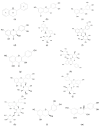Secondary Metabolites with Biomedical Applications from Plants of the Sarraceniaceae Family
- PMID: 36077275
- PMCID: PMC9456395
- DOI: 10.3390/ijms23179877
Secondary Metabolites with Biomedical Applications from Plants of the Sarraceniaceae Family
Abstract
Carnivorous plants have fascinated researchers and hobbyists for centuries because of their mode of nutrition which is unlike that of other plants. They are able to produce bioactive compounds used to attract, capture and digest prey but also as a defense mechanism against microorganisms and free radicals. The main purpose of this review is to provide an overview of the secondary metabolites with significant biological activity found in the Sarraceniaceae family. The review also underlines the necessity of future studies for the biochemical characterization of the less investigated species. Darlingtonia, Heliamphora and Sarracenia plants are rich in compounds with potential pharmaceutical and medical uses. These belong to several classes such as flavonoids, with flavonol glycosides being the most abundant, monoterpenes, triterpenes, sesquiterpenes, fatty acids, alkaloids and others. Some of them are well characterized in terms of chemical properties and biological activity and have widespread commercial applications. The review also discusses biological activity of whole extracts and commercially available products derived from Sarraceniaceae plants. In conclusion, this review underscores that Sarraceniaceae species contain numerous substances with the potential to advance health. Future perspectives should focus on the discovery of new molecules and increasing the production of known compounds using biotechnological methods.
Keywords: Sarraceniaceae; biological activity; secondary metabolites.
Conflict of interest statement
The author declares no conflict of interest. The funders had no role in the design of the study; in the collection, analyses or interpretation of data; in the writing of the manuscript, or in the decision to publish the results.
Figures





Similar articles
-
Metabolite profiling of the carnivorous pitcher plants Darlingtonia and Sarracenia.PLoS One. 2017 Feb 21;12(2):e0171078. doi: 10.1371/journal.pone.0171078. eCollection 2017. PLoS One. 2017. PMID: 28222171 Free PMC article.
-
Phylogeny and biogeography of the carnivorous plant family Sarraceniaceae.PLoS One. 2012;7(6):e39291. doi: 10.1371/journal.pone.0039291. Epub 2012 Jun 13. PLoS One. 2012. PMID: 22720090 Free PMC article.
-
Volatile organic compounds influence prey composition in Sarracenia carnivorous plants.PLoS One. 2023 Apr 19;18(4):e0277603. doi: 10.1371/journal.pone.0277603. eCollection 2023. PLoS One. 2023. PMID: 37074981 Free PMC article.
-
Jasmonate signalling in carnivorous plants: copycat of plant defence mechanisms.J Exp Bot. 2019 Jul 5;70(13):3379-3389. doi: 10.1093/jxb/erz188. J Exp Bot. 2019. PMID: 31120525 Review.
-
Carnivorous Plants from Nepenthaceae and Droseraceae as a Source of Secondary Metabolites.Molecules. 2023 Feb 24;28(5):2155. doi: 10.3390/molecules28052155. Molecules. 2023. PMID: 36903400 Free PMC article. Review.
Cited by
-
Omics Approaches in Uncovering Molecular Evolution and Physiology of Botanical Carnivory.Plants (Basel). 2023 Jan 15;12(2):408. doi: 10.3390/plants12020408. Plants (Basel). 2023. PMID: 36679121 Free PMC article. Review.
-
Shoots and Turions of Aquatic Plants as a Source of Fatty Acids.Molecules. 2024 Apr 29;29(9):2062. doi: 10.3390/molecules29092062. Molecules. 2024. PMID: 38731554 Free PMC article.
-
Inhibition of SARS-CoV-2 Nsp9 ssDNA-Binding Activity and Cytotoxic Effects on H838, H1975, and A549 Human Non-Small Cell Lung Cancer Cells: Exploring the Potential of Nepenthes miranda Leaf Extract for Pulmonary Disease Treatment.Int J Mol Sci. 2024 Jun 1;25(11):6120. doi: 10.3390/ijms25116120. Int J Mol Sci. 2024. PMID: 38892307 Free PMC article.
-
Biosynthesis and the Transcriptional Regulation of Terpenoids in Tea Plants (Camellia sinensis).Int J Mol Sci. 2023 Apr 8;24(8):6937. doi: 10.3390/ijms24086937. Int J Mol Sci. 2023. PMID: 37108101 Free PMC article. Review.
-
A review of herbal therapeutics for the prevention and management of poxvirus infections.Arch Microbiol. 2025 Jun 25;207(8):186. doi: 10.1007/s00203-025-04367-3. Arch Microbiol. 2025. PMID: 40560228 Review.
References
-
- Naczi R.F.C. Systematics and Evolution of Sarraceniaceae. In: Ellison A.M., Adamec L., editors. Carnivorous Plants. Physiology, Ecology and Evolution. Oxford University Press; Oxford, UK: 2018. pp. 105–119.
-
- Debuhr L.E. Distribution and Reproductive Biology of Darlingtonia Californica. Claremont Graduate School; Claremont, CA, USA: 1973.
-
- Mellichamp T.L. Sarraceniaceae. [(accessed on 22 August 2022)]. Available online: http://floranorthamerica.org/Sarraceniaceae.
-
- McPherson S., Wistuba A., Fleischmann A., Nerz J. Sarraceniaceae of South America. Redfern Natural History Productions; Poole, UK: 2011.
Publication types
MeSH terms
Substances
Grants and funding
LinkOut - more resources
Full Text Sources

